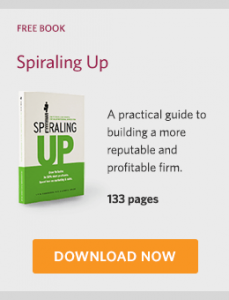It’s a hyper-competitive marketplace.
Firms are under an incredible amount of pressure to not only “get the job done” but also to be the go-to source for everything for their clients. Traditional thinking leads even more priority and support placed on an organization’s technical and operations professionals: the ones that traditionally get the acclaim for doing and delivering the work.
Traditional thinking also relegates marketing professionals to the role of support—and often to that of proposal machines. Indeed, being a marketer within the architecture, engineering, and construction (AEC) space can seem an uphill battle.
And let’s be honest, you’re up against decades of institutional thinking. The progressive generational shift in the workplace as Baby Boomers retire and Millennials solidify their stake may help alleviate some of that long-held stigma. But in the meantime, there are still things that marketing professionals can do to prove their worth.
(Note: The order that you address these recommendations is in a logical order. Naturally, the course that you choose to take should depend on your particular circumstances.)
 1. Gather your champions
1. Gather your champions
Being an AEC marketer is daunting. It can create a feeling that you don’t have an empathetic supporter in your corner.
Look for someone outside of the marketing function within your organization that really “gets” it or that has a particular interest or knack for business development. These individuals may already be doing some ad hoc marketing on their own to promote themselves or their practices. They may even be one of your firm’s Visible Experts.
The unifying thread for these individuals is that they understand the value and importance of marketing in achieving your organization’s overall strategic goals.
2. Have a solid plan
The adage “If you fail to plan, you are planning to fail” is often misattributed to Benjamin Franklin. Regardless of the actual author, this quote is indeed applicable to AEC marketing.
It is far too easy to get caught up in RFP responses, conference and awards submissions, and all of the other maintenance-oriented tasks that fall to the marketing department. It’s estimated that these tasks will consume upwards of half to three-quarters or more of a marketer’s time. Great ideas that may arise throughout the year only serve to be an additional stressor on an already full workload.
Developing a marketing plan is not a simple undertaking—and it definitely requires dedicated time and in-depth thought. But devoting the time to plan up front can make the difference between a successful initiative and what appears to non-marketers as a half-hearted attempt to complete a task.
Once your near-term plan is in place, start thinking about the bigger picture.
3. Seek out ways to collaborate with your technical colleagues
There’s more to working with non-marketing colleagues than proposal development and pitch preparation. Start out by scheduling one 15-minute check-in with a technical colleague to discuss one overarching goal for the following month. Gather some insights as to a concern or obstacle they may be facing in conjunction with that goal and what they may think would help them the most.
Be sure not to limit the discussion to the “marketing” lens. Looking at challenges from a broader standpoint can encourage more creative solutions. The added benefit is the chance to find common ground…and potentially be viewed in a different light.
Scheduling regular check-ins also helps you better anticipate issues and increase trust in your working relationships.
SEE ALSO: AEC Professionals: Collaborate with Your Marketing Teams for Competitive Advantage
4. Track key metrics…and learn how to share what matters with Management
Contrary to long-held belief, marketing really is a science. And it pays to change up your variables and experiment when and where you can.
With various paid and free resources available, marketing professionals are able to measure tactics, activities, and interactions online. A few ways to pinpoint your ROI (online and offline) include:
- A Customer Relationship Management (CRM) system will help connect all your conversion and traffic information from different channels. It allows you to see how your marketing efforts work together to support your new business pipeline.
- Google Analytics or other similar software can help you understand how visitors interact with your firm’s website and social media channels. Not only will an analytics program look at the raw traffic data, but it will allow you to dive deeper into visitor behavior and engagement patterns to help you determine where to adjust your marketing efforts.
- Direct feedback from prospects about how they found your firm is another great way to collect information on the unseen interactions that helped move the lead from a prospect to a client.
There are many other tools out there that can help you track progress—and know when to adjust your approach.
5. Never stop learning
Marketing is always changing and it’s important to stay on top of the trends. You don’t necessarily need an advanced degree. While that may help with certain career paths, it’s the practical know-how and experience that will have the biggest impact.
So, reach out to your network. Check out industry associations like the Society for Marketing Professional Services and the American Marketing Association, among others. Connect with other marketing professionals and exchange ideas at networking events or via targeted LinkedIn groups online.
And of course, the Internet is a great resource for free educational content by way of blogs, guides, ebooks, and more. The more you know, the more efficiently you can do your job and add to your organization.
No matter what tactics you employ, proactively find ways to tie what you do to your firm’s strategic goals. Relating to leadership by way of lead generation (to enhance business development) and associating marketing initiatives to the operational plan, among other methods, can help increase buy-in and help you gain the coveted “seat at the table.”
In what ways have you added value at your AEC firm? Share your tips in the comments below!
Additional Resources:
- Check out our free research-based book Inside the Buyer’s Brain to learn how your business development team can close more leads by understanding what the buyer really wants.
- Our Lead Nurturing Guide for Professional Services explains how you can craft a powerful lead nurturing strategy for your firm, so you can turn leads into clients.
How Hinge Can Help:
Hinge has developed a comprehensive plan, The Visible Firm℠ to address these issues and more. It is the leading marketing program for delivering greater visibility, growth, and profits. This customized program will identify the most practical offline and online marketing tools your firm will need to gain new clients and reach new heights.


